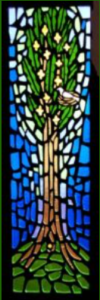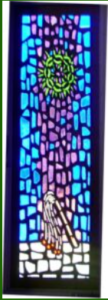
The archangel Gabriel, denoted by the large pair of wings, announces to the virgin, Mary, that God has chosen her to give birth to His son, Jesus. The purity and innocence of Mary is signified by the white lily and the white at the base of the window. The descending dove al- ways represents the Holy Spirit. The column of blue symbolized the grace of heaven against a green background of new life.
DEDICATION: This window was a gift of the Homebuilder’s Sunday School Class.

The birth of Jesus in a stable in Bethlehem is a scene familiar to every Christian. A royal blue background dramatizes the white purity and splendor of the star guiding the wise men and shepherds to the manger holding the Holy Babe. The Divine Presence is indicated by the golden nimbus above the manger. When a halo has the three rays in it, as this one does, it is used to represent members of the Trinity. The money bag, vase, and chest across the bottom symbolize the gold, frankincense, and myrrh, gifts brought to the Holy Christ by the Magi.
DEDICATION: This window was a gift of Otis and Joan Thomas in memory of our parents and in honor of our grandchildren.

This window is the only one of the sixteen to use two separate passages of Scripture. In the days of earliest childhood, Jesus is brought to the temple by his parents to be dedicated to the Lord. The two caged doves show their sacrifice, and the lavender panel denotes the sacrificial nature of Jesus’ entire life. Later, at the age of twelve, Jesus is again seen at the temple amongst the learned men of the time. The scroll at the top is representative of scripture, or the Torah.
DEDICATION: This window was the gift of Mr. & Mrs. Leland Davis and Harold and Hazel Bigsby.

The baptism of Jesus by John the Baptist is signified by a joyful golden background, centered by a column of green, the color of new life. The scallop shell with drops of water falling from it is one of the earliest symbols of the event. Very old paintings show John pouring water on the head of Jesus from a shell of this type. Three shades of blue across the lower section represent the river Jordan. Three fish symbolize the Trinity, or taken individually, as a sign of Jesus.
DEDICATION: This window was a gift of the Partners In Faith Sunday School Class in memory of Tony Williams.

The center column in this window can be seen as either the high mountain or the pillar of the temple to which the devil led Jesus after his forty days in the wilderness. The devil, or evil spirit, who tempted him is depicted by the form of the serpent atop the column. The green Chi Rho, formed by the first two letters of the name, Jesus, in the Greek alphabet, signifies the renewed spirit of our Lord. The sustaining grace of heaven is shown by blue, and the passion and trials of Jesus by the red.
DEDICATION: This window was the gift of Dennis and Jan Drysdale.

Green, the color of rebirth, surrounds the beginning of a new way of life for these two men. Henceforth casting out their next, shown in white, would reap not fish but followers for Jesus and believers in the kingdom of God. The crossed keys, or Saltire, are commonly used to represent Peter. The brown X-like cross, often call the St. Andrew cross, seen in the net represents Andrew, who supposedly died in Greece on a cross of this kind. The turquoise color is used for the sea water of Galilee.
DEDICATION: The window was the gift of the UMYF of St. Luke.

Against shadings of blue for the grace of heaven, streams a yellow and gold sunburst of glory, symbolizing the most important teachings of Jesus. It may also be viewed as a rayed cross. The green base represents the mountain- side and the three lilies the purity of Jesus. Outstanding among these passages of scripture are the beatitudes, the Lord’s Prayer, and the Golden Rule.
DEDICATION: This window was the gift of the Spiritual Life Sunday School Class.

Three shades of blue, denoting the grace of heaven, are centered by a golden column of joy and light. The dove, symbol of the Holy Spirit, hovers above a rainbow, token of God’s covenant to man. The broken chain symbolizes the freedom from bondage of the Israelites and also the free will of man.
DEDICATION: This window was a gift from Stanley and Cathy Davis.

This window is a pictorial interpretation of the parable as told by Jesus. The mustard seed, one of the smallest of all seeds, is faith in God, which once planted and nourished, grows mighty in strength and pro- vides shelter for all men. The nesting bird is shown because birds are often used to represent human souls. At the base of the tree is the tiny gold mustard seed.
DEDICATION: This window was the gift of the Emmanuel Sunday School Class in memory of all Emmanuel Class loved ones.

The gold and white of joy and purity are seen streaming down against a blue background of grace. A close look will show exactly five loaves and two fish in the basket, the numbers used by Jesus in one of the best known of his miracles. There is the green of the grass upon which they were commanded to sit and water in three shades of blue.
DEDICATION: This window was the gift of Mrs. Nita Mason in memory of my husband Paul C. Mason and my daughter Cherryll Mason McGuffin.

The center column of white denotes the purity and light emanating from Jesus. The flaming chariot is the symbol signifying the presence of Elijah, and Moses is represented by the two stone tablets with the Roman numerals from one to ten. The olive green is the mountaintop, scene of the Glory.
DEDICATION: This window was the gift of Dr. and Mrs. Norman Ellis in honor of our children, Deana Lynn Ellis and David Wayne Ellis, who taught us the real meaning of love.

The triumphal entry of Jesus into Jerusalem began the last week of His earthly life. Against a green back- ground of renewal, a golden pathway marks His way among joyful crowds. The palm branches represent those thrown down before Him. Often they are used to symbolize paradise, but especially in His entry as a symbol of victory. Palm Sunday is a celebration of this event. The small multi- colored patched over the gray of the street stones represent garments thrown down before Him.
DEDICATION: This window was the gift of Mr. and Mrs. Fred Mason, Jr. in memory of Mr. and Mrs. G. F. Mason Sr.

This window commemorates the last meal Jesus took with his closest followers, an event we are ad- monished by him to continue; “Do this in remembrance of me.” The lavender color denotes the sacrifice to come of Jesus’ life, which by this time he knew to be inevitable. The most common meaning of a bunch of grapes, especially when combined with sheaves of wheat, is that of Holy Communion. Wheat also stands for the “bread of life”. The golden chalice is in many places used in communion, but shown standing alone represents faith or worship. The red fortells the coming passion of Jesus.
DEDICATION: This window was the gift of Mr. & Mrs. Dana Sullivan, Penny and Susan in memory of Mrs. and Mrs. Frank Sullivan and Mr. C. T. Newton and in honor of Mrs. C. T. Newton.

Purple, the central color of this panel, is used to signify the sadness and suffering of Jesus. The columnar shape can be seen as representative of the scourging post. The whip, or scourge, used is seen at the lower part of the window. At the top is the crown of thorns, used to mock him as King of the Jews. The tan paving stones are symbolic of the streets or the road on the way to Calvary.
DEDICATION: This window was the gift of the Upper Room Sunday School Class in honor of Dr. Martha Chapman.

“And they brought him to the place called Golgotha (which means the place of the skull). And it was the third hour, when they crucified him. And the inscription of the charge against him read, ‘The King of the Jews’.” Mark 15:22, 25-26
A crimson background, red being the color of passion, sets off the starkness of the brown wooden cross upon which Jesus was nailed and died. At the top of the cross is a sign with the letters I N R I. These Roman letters are the abbreviation for the Latin words, “Jesus of Nazareth, the King of the Jews”. The sponge of vinegar which was held to his lips and the spear which pierced his side are shown to the left and the right of the cross.
DEDICATION: This window was the gift of the Friendship Sunday School Class.

“But the angel said to the women, ‘Do not be afraid; for I know that you seek Jesus who was crucified. He is not here; for he has risen, as he said. Come, see the place where he lay…’”
The glory of the resurrection is artistically interpreted by a central shaft of mingled yellow and white, denoting joy and purity, against the blue grace of heaven. This is surmounted by a butterfly done in green as symbolic of regeneration or new life. While the butterfly is not scriptural, it is very expressive of Christian belief, paralleling the stages in the life of a Christian. First the larva (man’s mortal life), next the chrysalis (death or dormancy), then a beautiful soaring butterfly (eternal life through faith in Jesus Christ). The red flowers at the bottom are pomegranates mentioned often in the Old Testament. When pomegranates ripen, their seeds burst forth. Just as the pod is unable to hold them, so the grave was unable to hold Jesus.
Dedication: This window was a gift of the Tony Williams Memorial Fund given in memory of Tony Williams.
